Abstract
Long-latency (40-80 ms) electromyographic (e.m.g.) responses of the contracting flexor pollicis longus to stretches applied at the thumb-tip, were studied in normal human subjects. Stretches were applied during four classes of contraction: (i) isometric 'hold', in which the subject held a steady isometric contraction; (ii) isometric tracking, in which the subject tracked a steadily rising force target; (iii) isotonic tracking, in which the subject flexed against a constant torque to track a position target; (iv) weight-lifting, in which the subject lifted a weight hung at one end of a lever by pressing the thumb-tip on the other end of the lever. The effects on the responses of prior instructions to 'resist' or to 'let go', and of local anaesthesia of the thumb, were studied. The ability to modify the size of the long-latency e.m.g. response in accordance with prior instruction was variable. All subjects tested could do so during isometric holding contractions, but many could not do so during the other forms of contraction. Local anaesthesia of the thumb significantly reduced the long-latency e.m.g. response in only some subjects, and abolished it in none. The reduction was most reliably seen for isometric force tracking contractions. During thumb anaesthesia in different subjects, there was a significant correlation between the proportional increase in apparent heaviness of an object lifted by thumb flexion and the proportional reduction in the size of the long-latency e.m.g. response to muscle stretch.
Full text
PDF
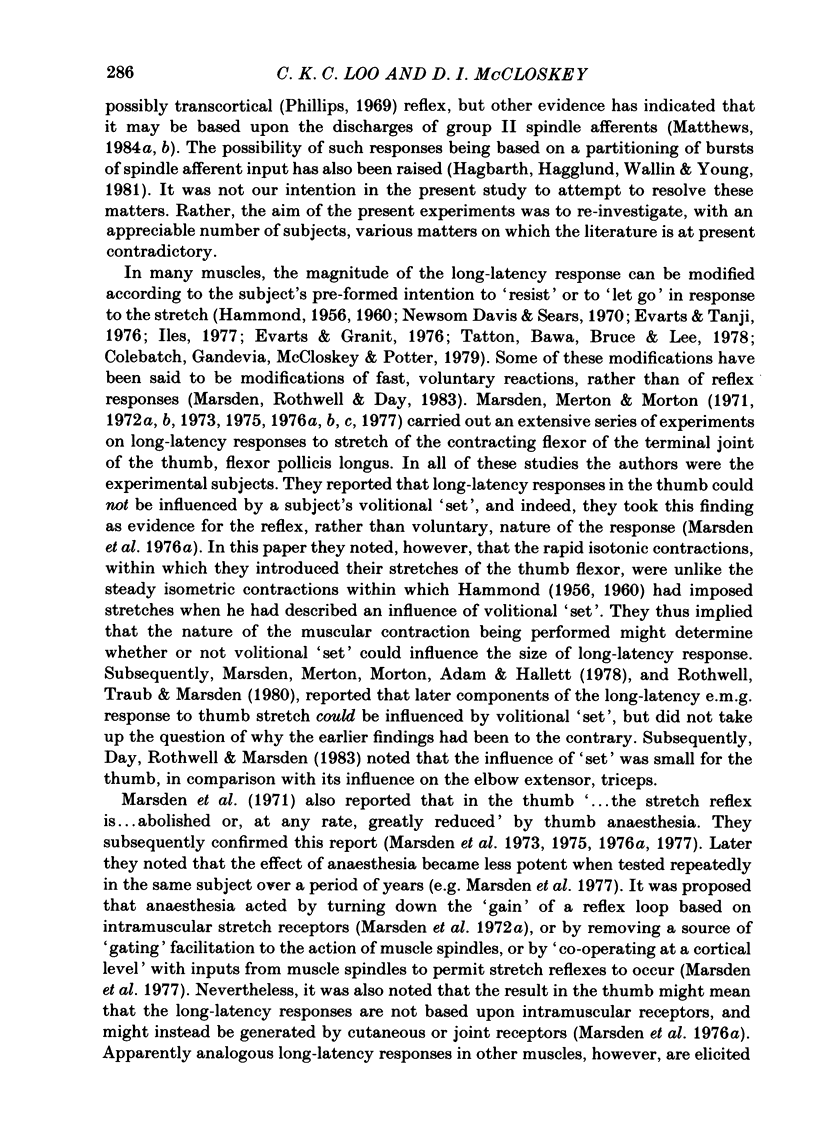
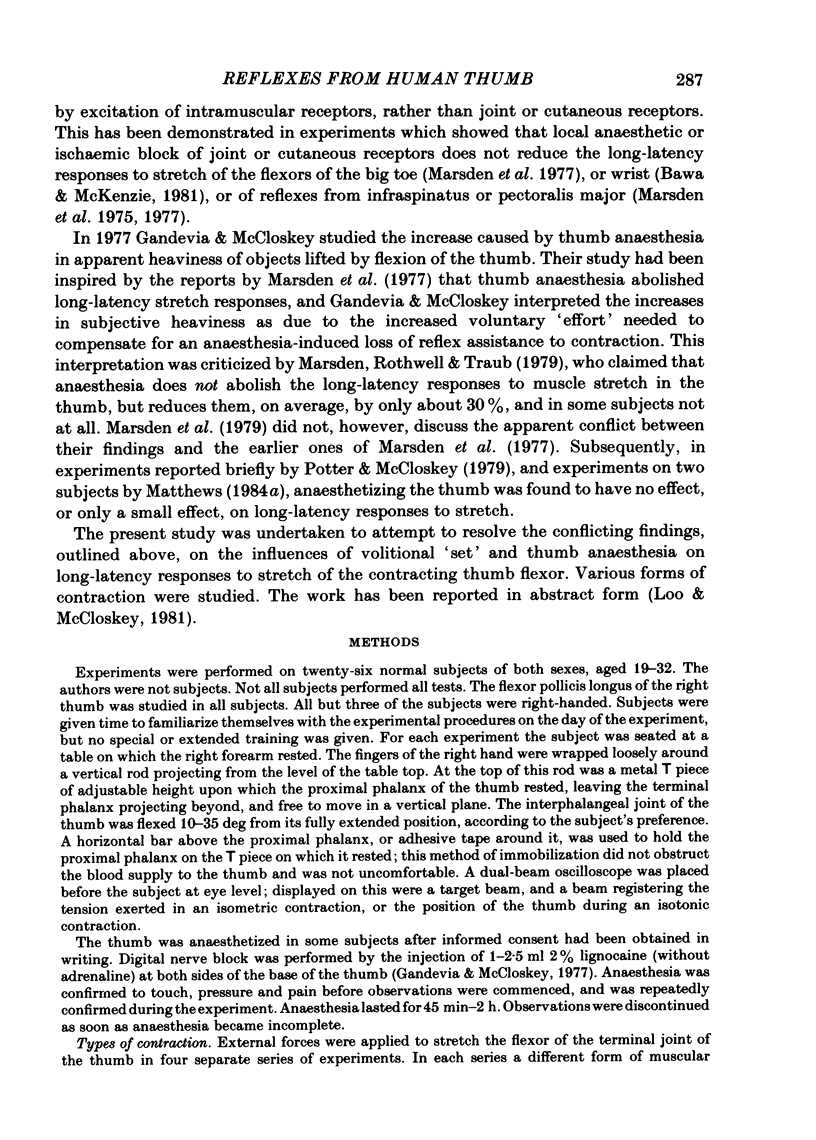
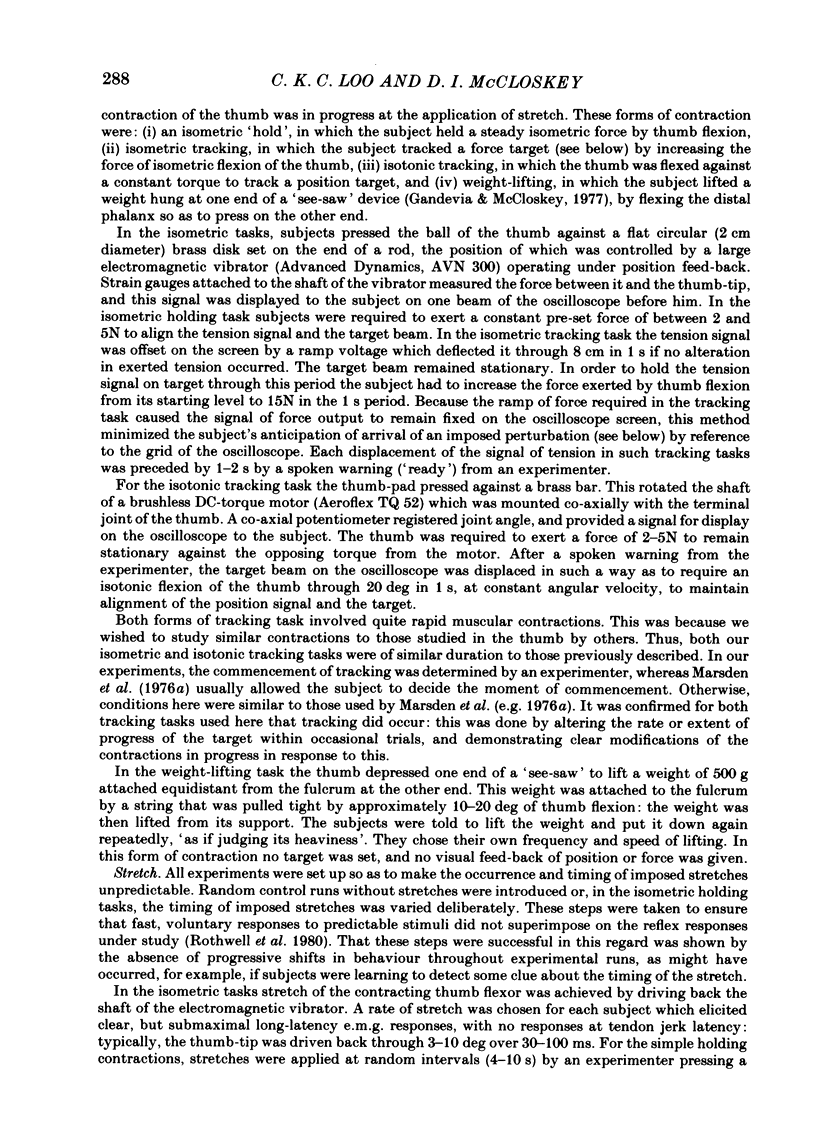
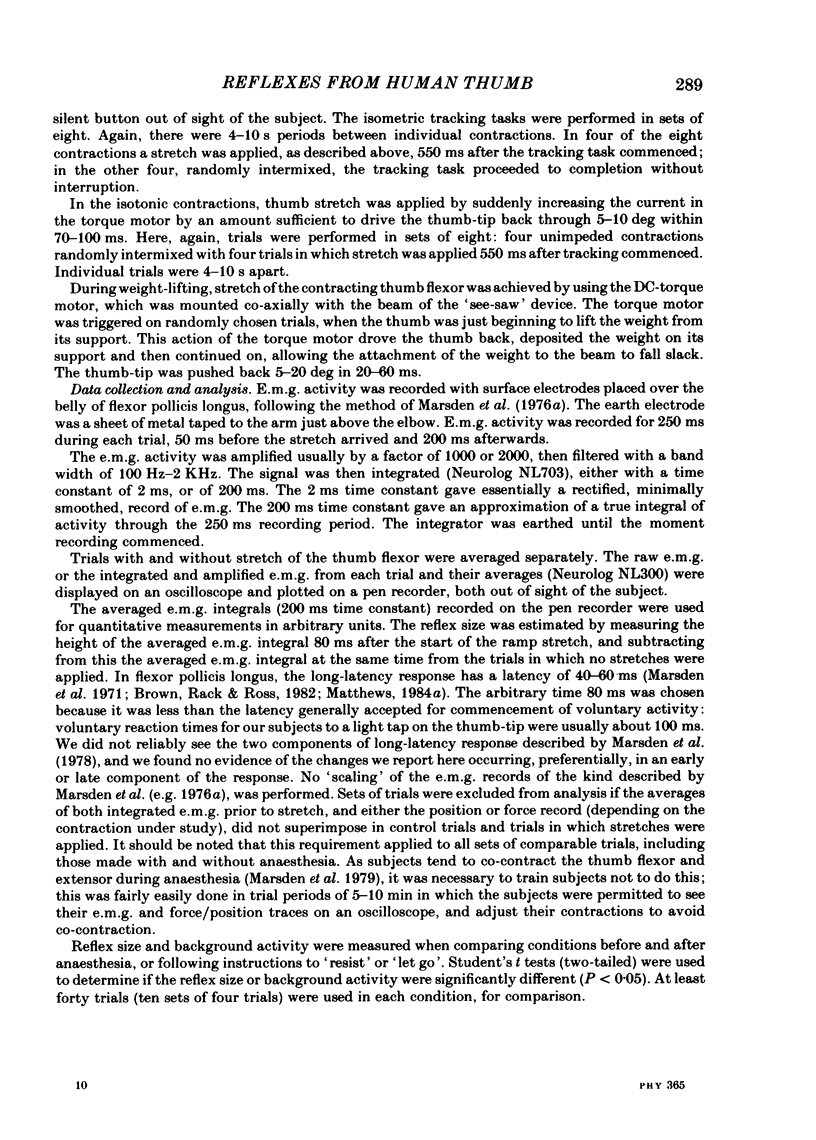
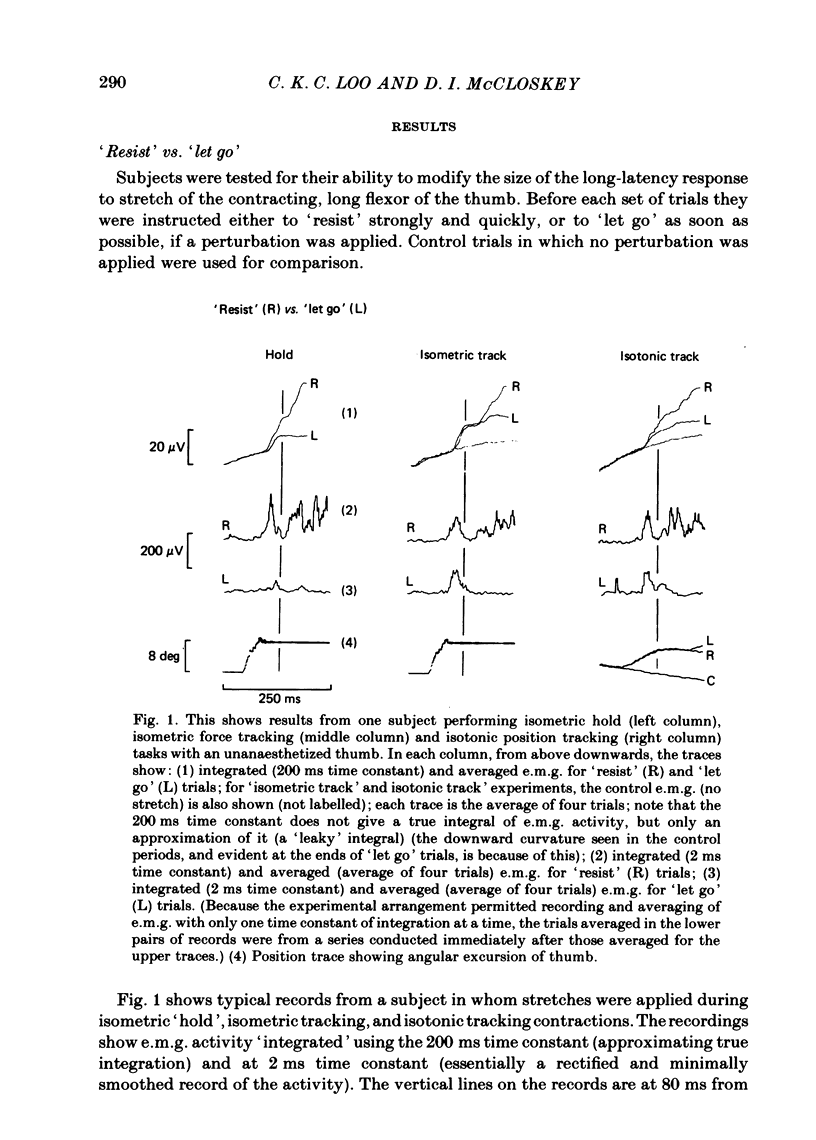

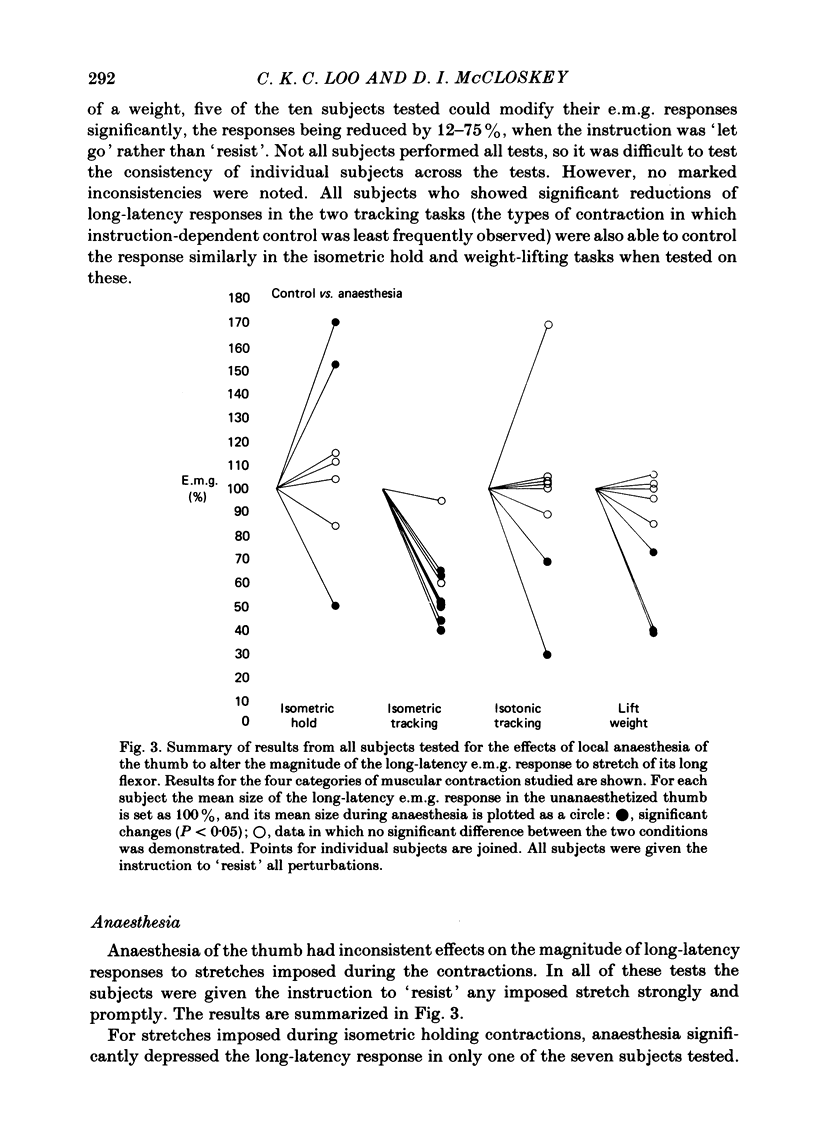
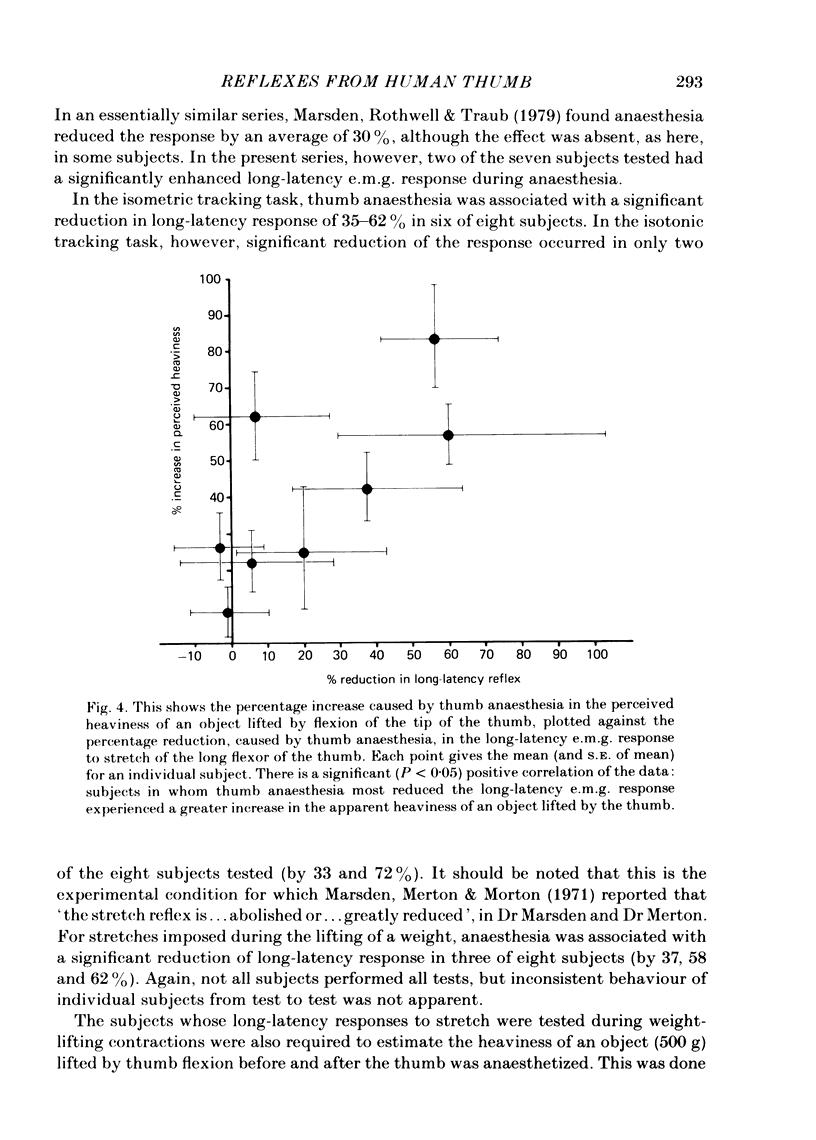
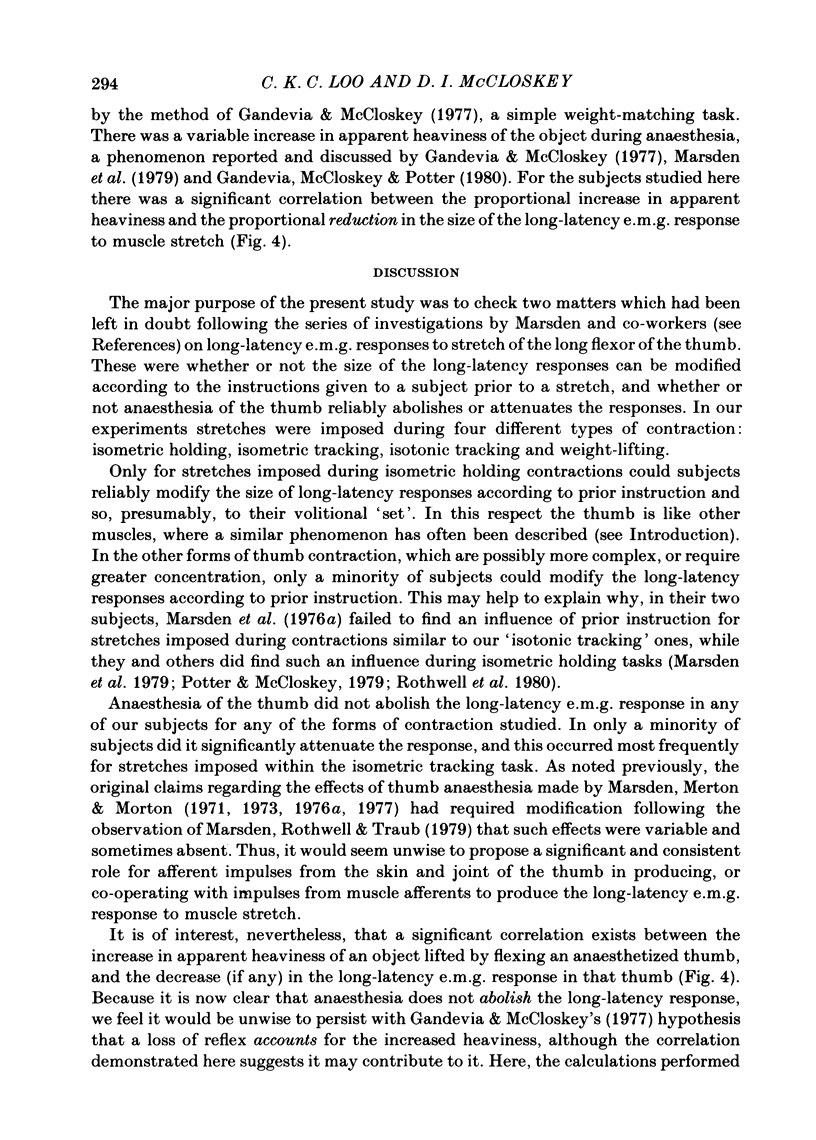
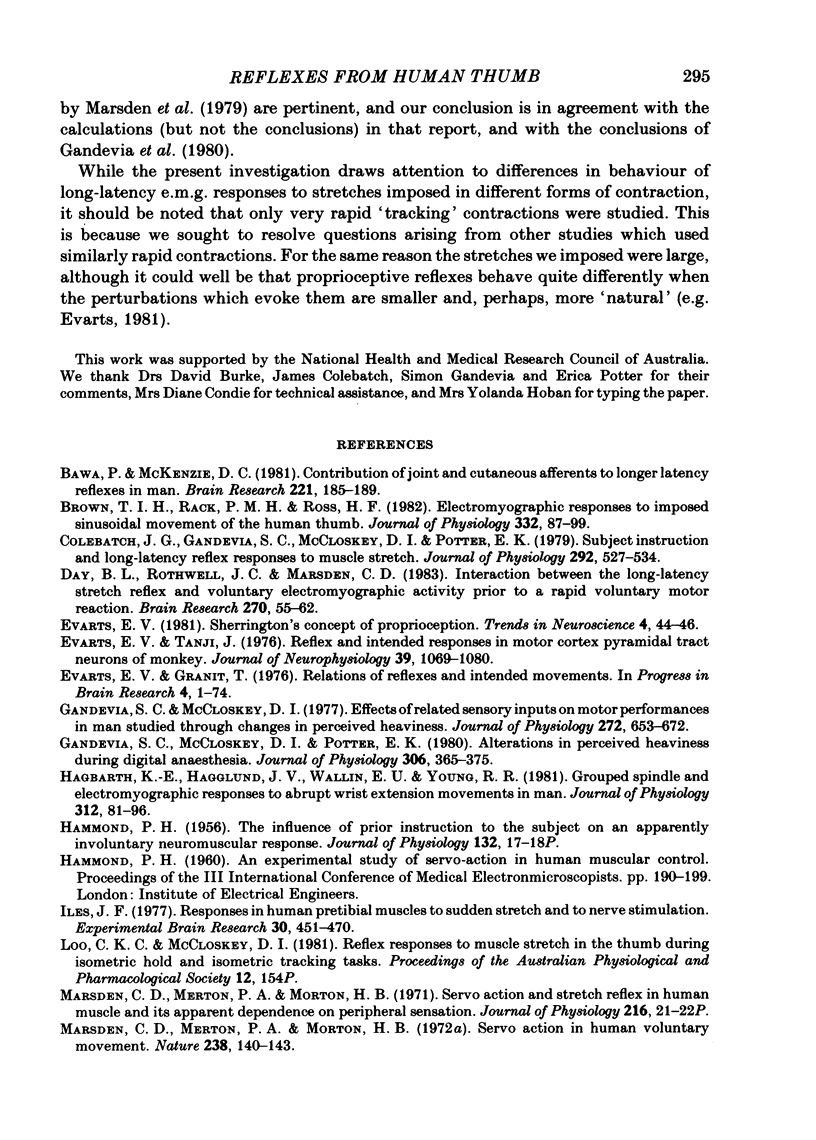

Selected References
These references are in PubMed. This may not be the complete list of references from this article.
- Bawa P., McKenzie D. C. Contribution of joint and cutaneous afferents to longer-latency reflexes in man. Brain Res. 1981 Apr 27;211(1):185–189. doi: 10.1016/0006-8993(81)90081-0. [DOI] [PubMed] [Google Scholar]
- Brown T. I., Rack P. M., Ross H. F. Electromyographic responses to imposed sinusoidal movement of the human thumb. J Physiol. 1982 Nov;332:87–99. doi: 10.1113/jphysiol.1982.sp014402. [DOI] [PMC free article] [PubMed] [Google Scholar]
- Colebatch J. G., Gandevia S. C., McCloskey D. I., Potter E. K. Subject instruction and long latency reflex responses to muscle stretch. J Physiol. 1979 Jul;292:527–534. doi: 10.1113/jphysiol.1979.sp012869. [DOI] [PMC free article] [PubMed] [Google Scholar]
- Davis J. N., Sears T. A. The proprioceptive reflex control of the intercostal muscles during their voluntary activation. J Physiol. 1970 Aug;209(3):711–738. doi: 10.1113/jphysiol.1970.sp009188. [DOI] [PMC free article] [PubMed] [Google Scholar]
- Day B. L., Rothwell J. C., Marsden C. D. Interaction between the long-latency stretch reflex and voluntary electromyographic activity prior to a rapid voluntary motor reaction. Brain Res. 1983 Jun 27;270(1):55–62. doi: 10.1016/0006-8993(83)90791-6. [DOI] [PubMed] [Google Scholar]
- Evarts E. V., Granit R. Relations of reflexes and intended movements. Prog Brain Res. 1976;44:1–14. doi: 10.1016/S0079-6123(08)60719-0. [DOI] [PubMed] [Google Scholar]
- Evarts E. V., Tanji J. Reflex and intended responses in motor cortex pyramidal tract neurons of monkey. J Neurophysiol. 1976 Sep;39(5):1069–1080. doi: 10.1152/jn.1976.39.5.1069. [DOI] [PubMed] [Google Scholar]
- Gandevia S. C., McCloskey D. I. Effects of related sensory inputs on motor performances in man studied through changes in perceived heaviness. J Physiol. 1977 Nov;272(3):653–672. doi: 10.1113/jphysiol.1977.sp012065. [DOI] [PMC free article] [PubMed] [Google Scholar]
- Gandevia S. C., McCloskey D. I., Potter E. K. Alterations in perceived heaviness during digital anaesthesia. J Physiol. 1980 Sep;306:365–375. doi: 10.1113/jphysiol.1980.sp013402. [DOI] [PMC free article] [PubMed] [Google Scholar]
- HAMMOND P. H. The influence of prior instruction to the subject on an apparently involuntary neuro-muscular response. J Physiol. 1956 Apr 27;132(1):17–8P. [PubMed] [Google Scholar]
- Hagbarth K. E., Hägglund J. V., Wallin E. U., Young R. R. Grouped spindle and electromyographic responses to abrupt wrist extension movements in man. J Physiol. 1981 Mar;312:81–96. doi: 10.1113/jphysiol.1981.sp013617. [DOI] [PMC free article] [PubMed] [Google Scholar]
- Iles J. F. Responses in human pretibial muscles to sudden stretch and to nerve stimulation. Exp Brain Res. 1977 Dec 19;30(4):451–470. doi: 10.1007/BF00237637. [DOI] [PubMed] [Google Scholar]
- Marsden C. D., Merton P. A., Morton H. B. Behaviour of short and long latency components of the stretch reflex in human muscle. J Physiol. 1975 Mar;246(2):43P–44P. [PMC free article] [PubMed] [Google Scholar]
- Marsden C. D., Merton P. A., Morton H. B. Is the human stretch reflex cortical rather than spinal? Lancet. 1973 Apr 7;1(7806):759–761. doi: 10.1016/s0140-6736(73)92141-7. [DOI] [PubMed] [Google Scholar]
- Marsden C. D., Merton P. A., Morton H. B. Servo action and stretch reflex in human muscle and its apparent dependence on peripheral sensation. J Physiol. 1971 Jul;216(1):21P–22P. [PubMed] [Google Scholar]
- Marsden C. D., Merton P. A., Morton H. B. Servo action in human posture [proceedings]. J Physiol. 1976 Dec;263(1):187P–188P. [PubMed] [Google Scholar]
- Marsden C. D., Merton P. A., Morton H. B. Servo action in human voluntary movement. Nature. 1972 Jul 21;238(5360):140–143. doi: 10.1038/238140a0. [DOI] [PubMed] [Google Scholar]
- Marsden C. D., Merton P. A., Morton H. B. Servo action in the human thumb. J Physiol. 1976 May;257(1):1–44. doi: 10.1113/jphysiol.1976.sp011354. [DOI] [PMC free article] [PubMed] [Google Scholar]
- Marsden C. D., Merton P. A., Morton H. B. Stretch reflex and servo action in a variety of human muscles. J Physiol. 1976 Jul;259(2):531–560. doi: 10.1113/jphysiol.1976.sp011481. [DOI] [PMC free article] [PubMed] [Google Scholar]
- Marsden C. D., Merton P. A., Morton H. B. The sensory mechanism of servo action in human muscle. J Physiol. 1977 Feb;265(2):521–535. doi: 10.1113/jphysiol.1977.sp011728. [DOI] [PMC free article] [PubMed] [Google Scholar]
- Marsden C. D., Rothwell J. C., Day B. L. Long-latency automatic responses to muscle stretch in man: origin and function. Adv Neurol. 1983;39:509–539. [PubMed] [Google Scholar]
- Marsden C. D., Rothwell J. C., Traub M. M. Effect of thumb anaesthesia on weight perception, muscle activity and the stretch reflex in man. J Physiol. 1979 Sep;294:303–315. doi: 10.1113/jphysiol.1979.sp012931. [DOI] [PMC free article] [PubMed] [Google Scholar]
- Matthews P. B. Evidence from the use of vibration that the human long-latency stretch reflex depends upon spindle secondary afferents. J Physiol. 1984 Mar;348:383–415. doi: 10.1113/jphysiol.1984.sp015116. [DOI] [PMC free article] [PubMed] [Google Scholar]
- Matthews P. B. The contrasting stretch reflex responses of the long and short flexor muscles of the human thumb. J Physiol. 1984 Mar;348:545–558. doi: 10.1113/jphysiol.1984.sp015124. [DOI] [PMC free article] [PubMed] [Google Scholar]
- Phillips C. G. The Ferrier lecture, 1968. Motor apparatus of the baboon's hand. Proc R Soc Lond B Biol Sci. 1969 May 20;173(1031):141–174. doi: 10.1098/rspb.1969.0044. [DOI] [PubMed] [Google Scholar]
- Rothwell J. C., Traub M. M., Marsden C. D. Influence of voluntary intent on the human long-latency stretch reflex. Nature. 1980 Jul 31;286(5772):496–498. doi: 10.1038/286496a0. [DOI] [PubMed] [Google Scholar]
- Tatton W. G., Forner S. D., Gerstein G. L., Chambers W. W., Liu C. N. The effect of postcentral cortical lesions on motor responses to sudden upper limb displacements in monkeys. Brain Res. 1975 Oct 10;96(1):108–113. doi: 10.1016/0006-8993(75)90580-6. [DOI] [PubMed] [Google Scholar]


